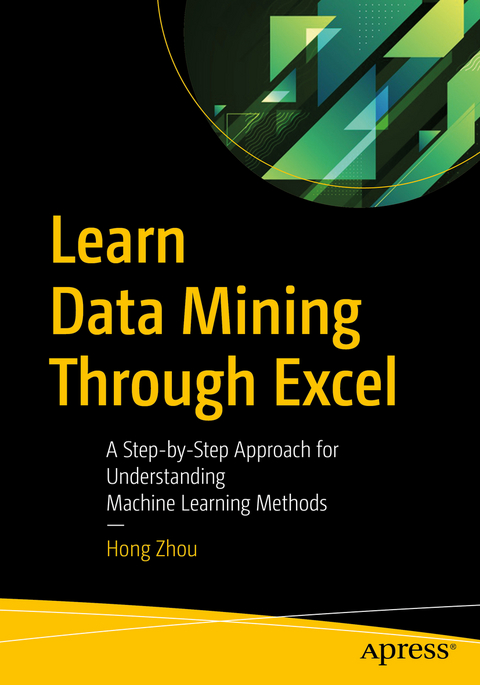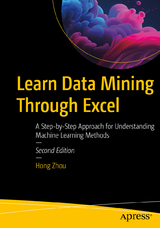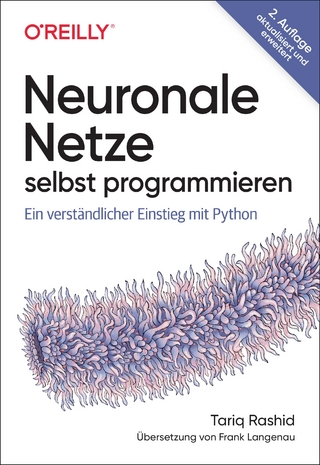
Learn Data Mining Through Excel
Apress (Verlag)
978-1-4842-5981-8 (ISBN)
- Titel erscheint in neuer Auflage
- Artikel merken
Use popular data mining techniques in Microsoft Excel to better understand machine learning methods.
Software tools and programming language packages take data input and deliver data mining results directly, presenting no insight on working mechanics and creating a chasm between input and output. This is where Excel can help.
Excel allows you to work with data in a transparent manner. When you open an Excel file, data is visible immediately and you can work with it directly. Intermediate results can be examined while you are conducting your mining task, offering a deeper understanding of how data is manipulated and results are obtained. These are critical aspects of the model construction process that are hidden in software tools and programming language packages.
This book teaches you data mining through Excel. You will learn how Excel has an advantage in data mining when the data sets are not too large. It can give you a visual representation of data mining, building confidence in your results. You will go through every step manually, which offers not only an active learning experience, but teaches you how the mining process works and how to find the internal hidden patterns inside the data.
What You Will Learn
Comprehend data mining using a visual step-by-step approach
Build on a theoretical introduction of a data mining method, followed by an Excel implementation
Unveil the mystery behind machine learning algorithms, making a complex topic accessible to everyone
Become skilled in creative uses of Excel formulas and functions
Obtain hands-on experience with data mining and Excel
Who This Book Is For
Anyone who is interested in learning data mining or machine learning, especially data science visual learners and people skilled in Excel, who would like to explore data science topics and/or expand their Excel skills. A basic or beginner level understanding of Excel is recommended.
Hong Zhou, PhD is a professor of computer science and mathematics and has been teaching courses in computer science, data science, mathematics, and informatics at the University of Saint Joseph for more than 15 years. His research interests include bioinformatics, data mining, software agents, and blockchain. Prior to his current position, he was as a Java developer in Silicon Valley. Dr. Zhou believes that learners can develop a better foundation of data mining models when they visually experience them step-by-step, which is what Excel offers. He has employed Excel in teaching data mining and finds it an effective approach for both data mining learners and educators.
Chapter 1: Excel and Data Mining
Chapter 2: Linear Regression
Chapter 3: K-Means Clustering
Chapter 4: Linear discriminant analysis
Chapter 5: Cross validation and ROC
Chapter 6: Logistic regression
Chapter 7: K-nearest neighborsChapter 8: Naïve Bayes classification
Chapter 9: Decision Trees
Chapter 10: Association analysisChapter 11: Artificial Neural network
Chapter 12: Text Mining
Chapter 13: After Excel
| Erscheinungsdatum | 30.06.2020 |
|---|---|
| Zusatzinfo | 176 Illustrations, black and white; XVI, 219 p. 176 illus. |
| Verlagsort | Berkley |
| Sprache | englisch |
| Maße | 178 x 254 mm |
| Gewicht | 456 g |
| Themenwelt | Informatik ► Datenbanken ► Data Warehouse / Data Mining |
| Mathematik / Informatik ► Informatik ► Software Entwicklung | |
| Informatik ► Theorie / Studium ► Künstliche Intelligenz / Robotik | |
| Schlagworte | Clustering • Cross-validation • Data Analysis • Data Classification • Data Mining • decision trees • Excel • Hong Zhou Excel • K-means clustering • linear regresssion • Logistic regression analysis • machine learning • Naive Bayes • Nearest Neighbors • neural network |
| ISBN-10 | 1-4842-5981-5 / 1484259815 |
| ISBN-13 | 978-1-4842-5981-8 / 9781484259818 |
| Zustand | Neuware |
| Informationen gemäß Produktsicherheitsverordnung (GPSR) | |
| Haben Sie eine Frage zum Produkt? |
aus dem Bereich



